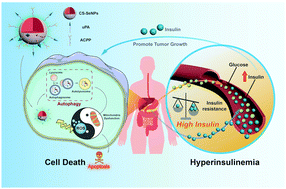Dual-targeting nanotherapeutics antagonize hyperinsulinemia-promoted tumor growth via activating cell autophagy†
Abstract
Hyperinsulinemia, a concomitant symptom in type 2 diabetes mellitus (T2DM) promotes the migration, invasion and proliferation of tumors by inhibiting autophagy. Therefore, it is necessary to search for antitumor drugs that can effectively antagonize hyperinsulinemia by promoting autophagy. In this study, dual-targeting modified selenium nanoparticles (u/A-SeNPs) were proposed as a biocompatible tumor chemotherapeutic drug to antagonize high insulin. The modification of chitosan (CS) and grafting targeted peptides (uPA/ACPP) allowed SeNPs to exert better selectivity and higher antitumor activity. The nanotherapeutics entered tumor cells through receptor-mediated endocytosis and produced excessive ROS. Meanwhile, u/A-SeNPs significantly increased the level of autophagy in tumor cells, as detected by monodansylcadaverine (MDC) and mRFP-GFP-LC3. U/A-SeNPs cause mitochondrial fragmentation to induce the cell apoptosis via the synergistic action of overproduced ROS and activated autophagy. In conclusion, this study proposes a feasible method for the synthesis of dual-targeting nanomedicines, and it also provides a new strategy for the application of Se-based nanotherapeutics in tumor therapy under hyperinsulinemia conditions.



 Please wait while we load your content...
Please wait while we load your content...